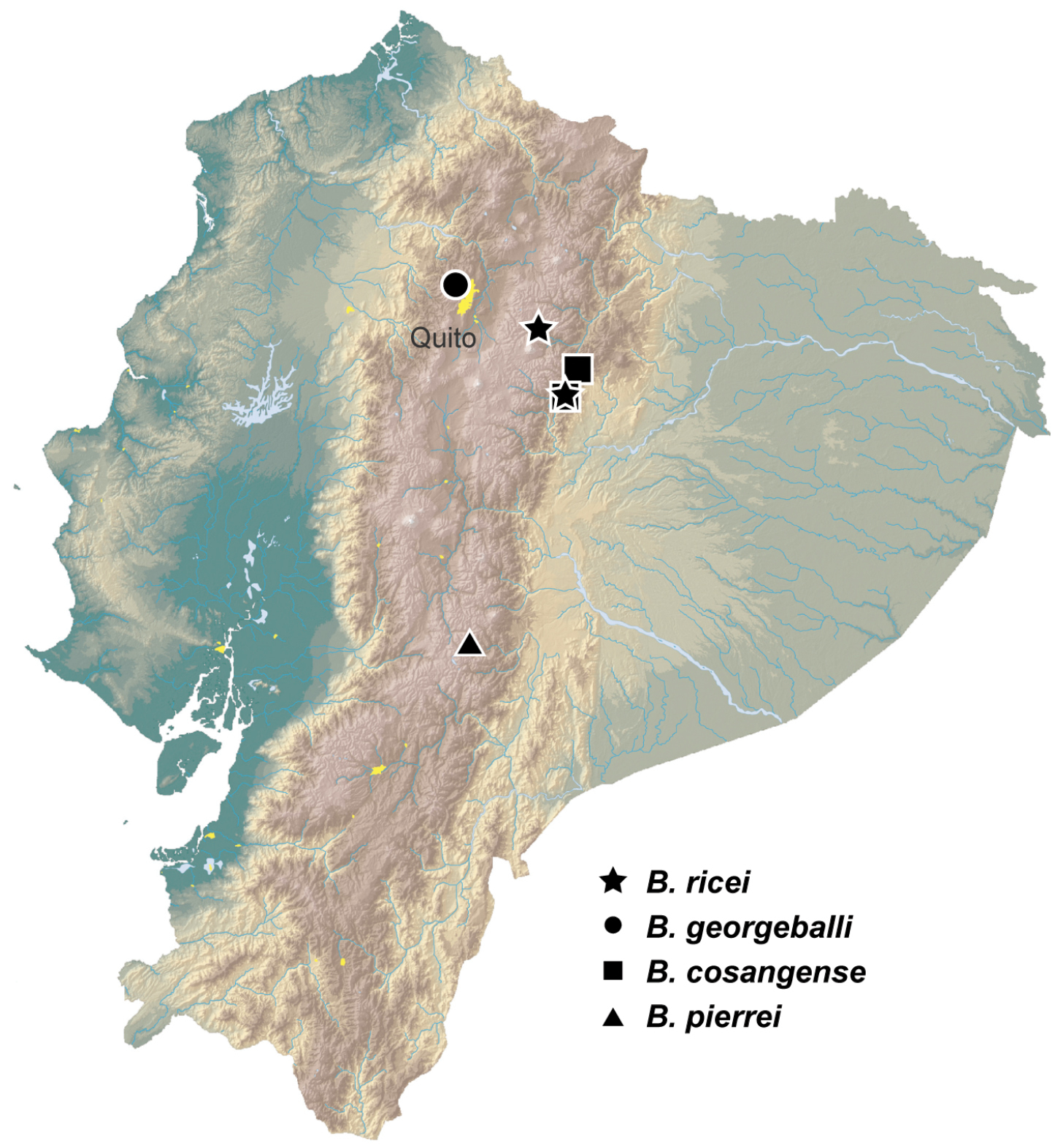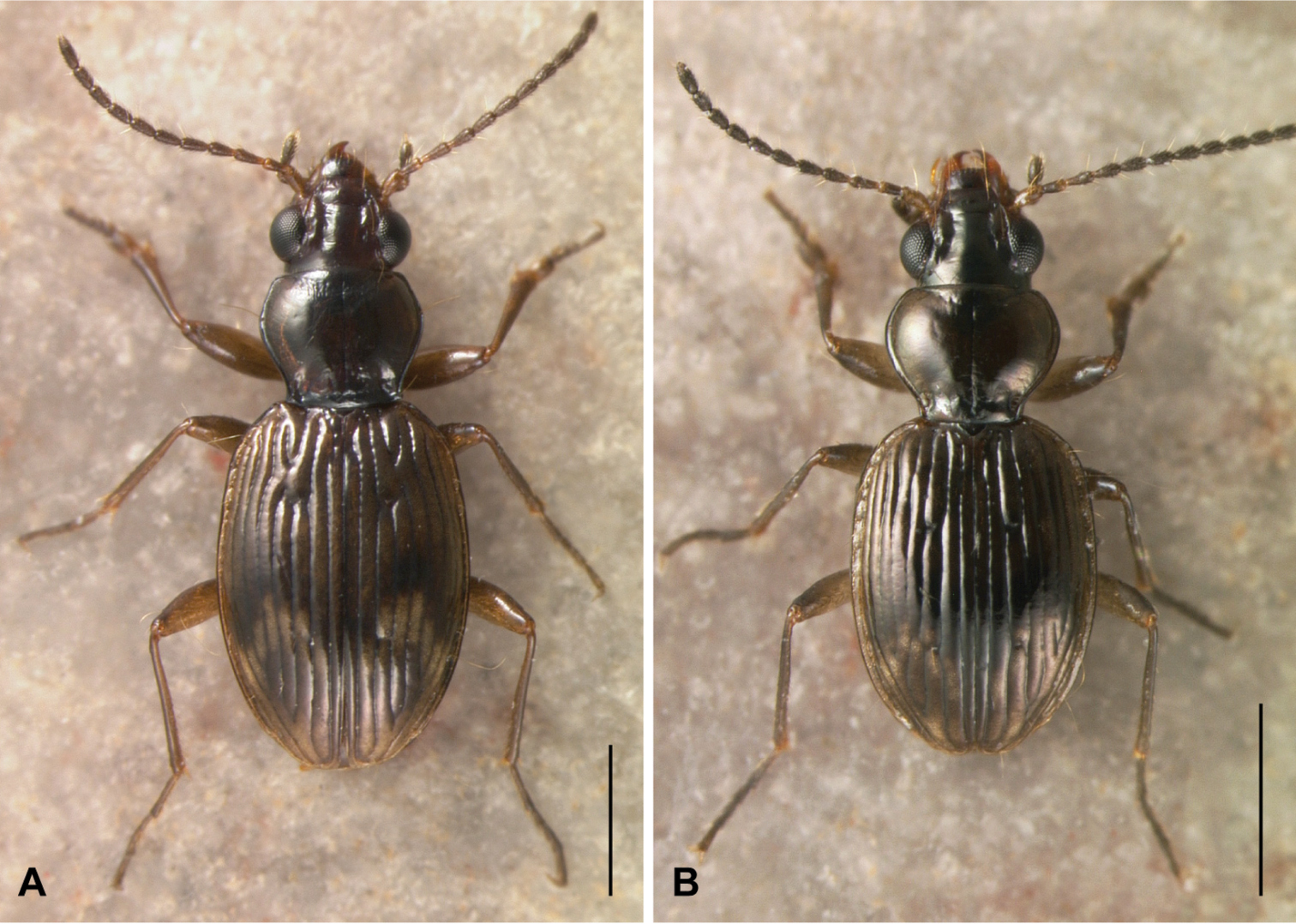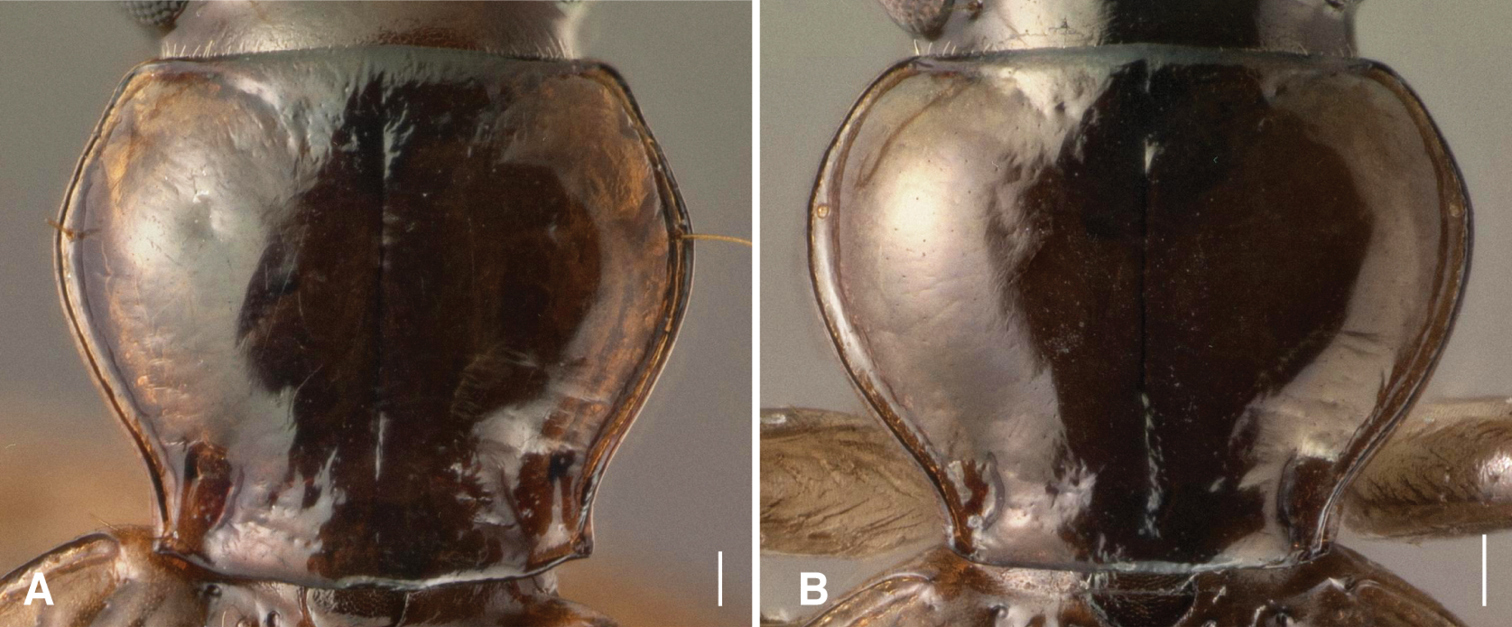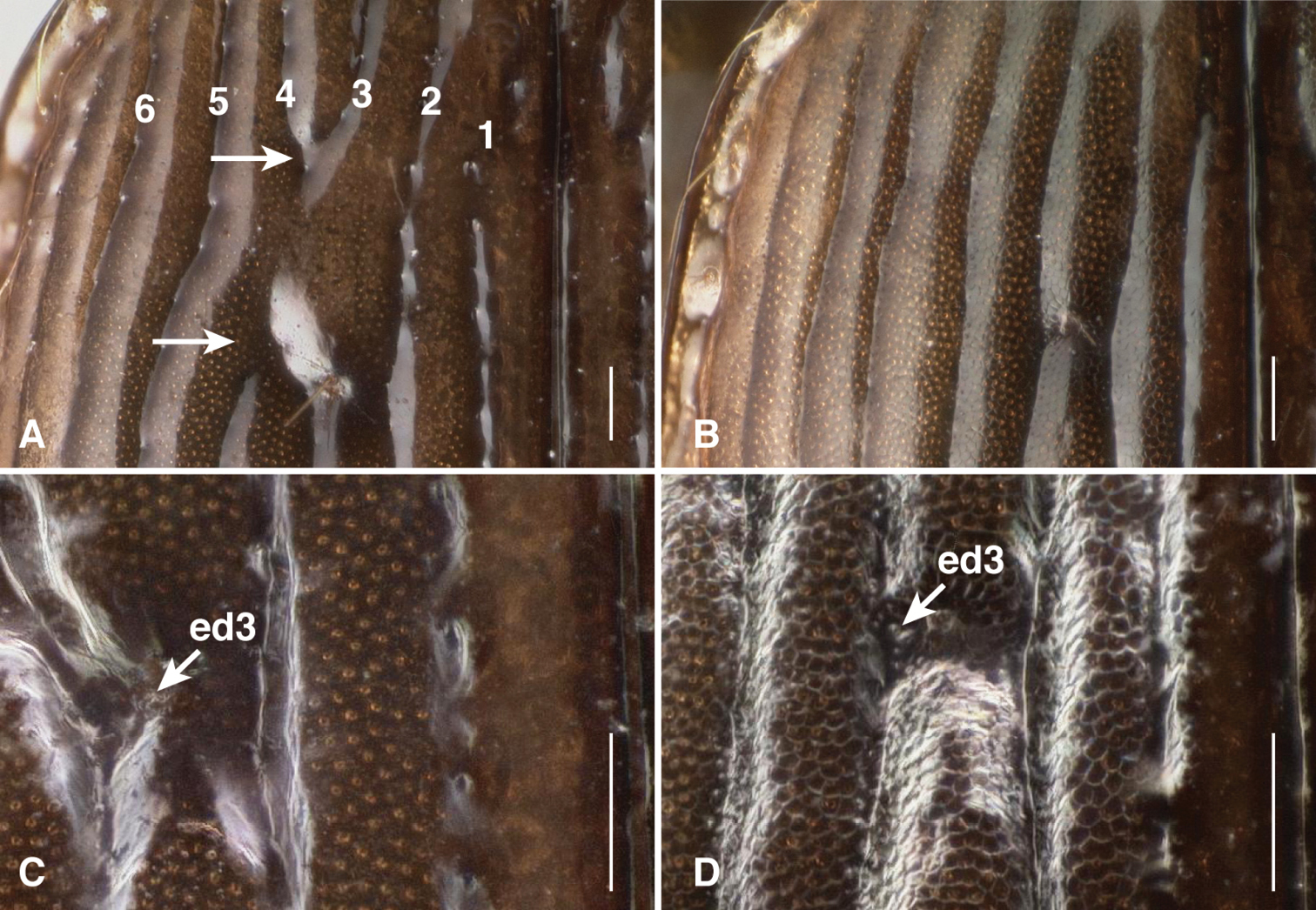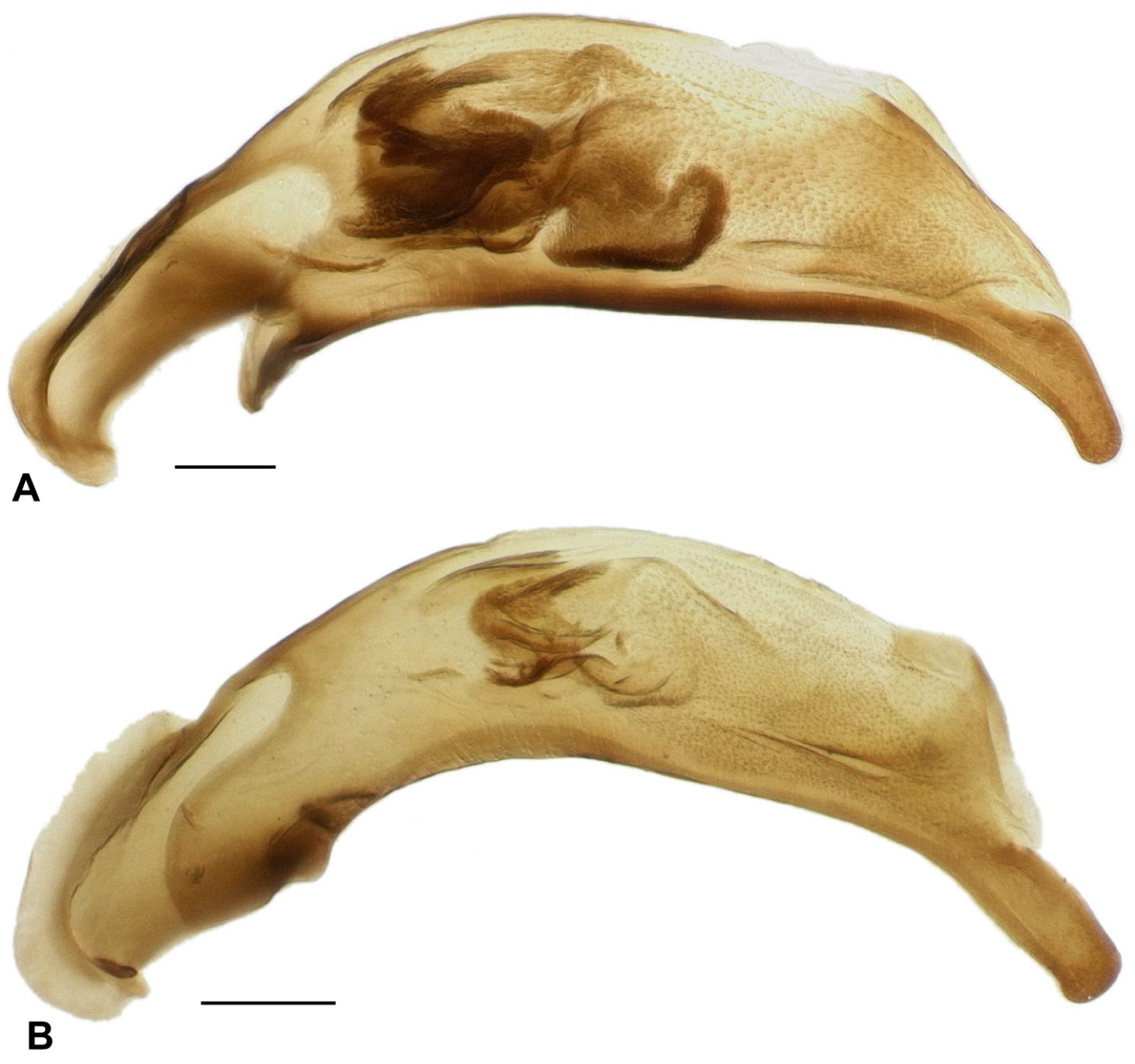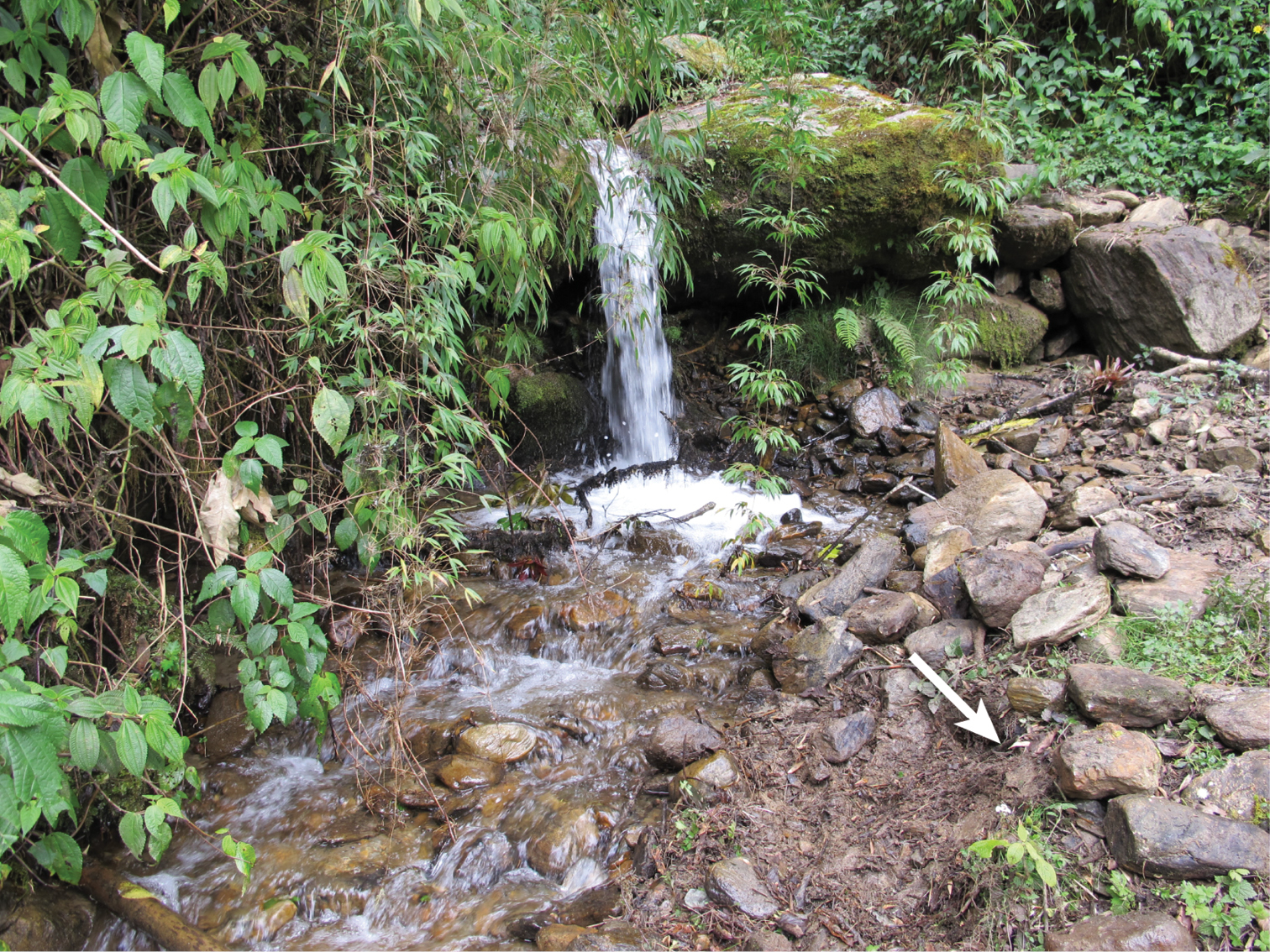






(C) 2012 David R. Maddison. This is an open access article distributed under the terms of the Creative Commons Attribution License 3.0 (CC-BY), which permits unrestricted use, distribution, and reproduction in any medium, provided the original author and source are credited.
For reference, use of the paginated PDF or printed version of this article is recommended.
A new species of ground beetle, Bembidion ricei, is described from the Andes mountains of Ecuador east of Quito. It belongs to the georgeballi species group of subgenus Ecuadion, and is most similar to Bembidion georgeballi. A key to the species of the group is provided.
Bembidion, Trechinae, Bembidiini, DNA, morphology, taxonomy, systematics
Ecuadion is a diverse subgenus of Bembidion restricted to higher elevations in South and Central America (
In Toledano’s (2008) study on the Northern Andean fauna of Bembidion, he illustrated (his Figure 21) a single female belonging to the georgeballi species group from Rio Chalpi, Ecuador, noting that it was similar to Bembidion georgeballi but that it may represent a separate species; the decision about its status was postponed until males could be discovered. In 2010, the senior author and colleagues collected specimens of this form from the same region from which Toledano’s specimen originated. The larger series and characteristics of the male genitalia indicate that this form is a species distinct from Bembidion georgeballi, and it is here described, and compared to other members of the georgeballi group.
Several hundred specimens of Ecuadion were examined as part of this study, including 50 specimens of Bembidion georgeballi and 16 specimens of Bembidion ricei, sp. n. Specimens came from or have been deposited in the collections listed below. Each collection’s listing begins with the coden used in the text.
BMNH The Natural History Museum, London
CTVR Luca Toledano Collection, Verona, Italy
MNHN Muséum National d’Histoire Naturelle, Paris
OSAC Oregon State Arthropod Collection, Oregon State University, Corvallis
QCAZ Catholic University of Ecuador, Quito
USNM National Museum of Natural History, Smithsonian Institution, Washington
Methods of specimen preparation for morphological work, and terms used, are given in
Photographs of body parts were taken with a Leica Z6 and JVC KY-F75U camera. For pronotal, elytral, and genitalic images, a stack of photographs at different focal planes was taken using Microvision’s Cartograph software; these photographs were then merged using the PMax procedure in Zerene Systems’s Zerene Stacker; the images thus potentially have some artifacts caused by the merging algorithm.
Sequences of 28S ribosomal DNA and cytochrome oxidase I genes were obtained using the protocols given in
Among Ecuadion, adults of the georgeballi group are characterized by convex elytral intervals, with deep and complete elytral striae, and with elytra reddish or with yellowish markings (
Bembidion georgeballi Toledano [Ecuador]
Bembidion ricei Maddison and Toledano [Ecuador]
Bembidion pierrei Toledano [Ecuador]
Bembidion cosangaense Toledano [Ecuador]
Bembidion guaramacal Toledano [Venezuela]
Geographic distribution of known members of the georgeballi species group in Ecuador. Base map modified from
| 1 | Elytra reddish, unicolorous; if with a faint, slightly darker spot, then with a pale rufous pronotum (see |
2 |
| – | Elytra with a mottled testaceous and brown pattern, pronotum darker, at least centrally (Fig. 2) | 3 |
| 2 | Pronotum piceous-black, narrower (pronotal width/length = 1.17 to 1.20), elytra reddish, unicolorous; Ecuador | Bembidion cosangaense |
| – | Pronotum rufous, wider (pronotal width/length = 1.32 to 1.33), elytra reddish, sometimes with a faint, slightly darker spot; Venezuela | Bembidion guaramacal |
| 3 | Posterior lateral seta and carina of pronotum both absent, pronotum more constricted at hind angles (Fig. 3B) | Bembidion georgeballi |
| – | Posterior lateral seta and carina of pronotum both present, pronotum less constricted at hind angles (e.g., Fig. 3A) | 4 |
| 4 | Microsculpture absent from elytra in males and females; elytral striae 3 and 4 connected in front of the anterior discal seta (see Fig. 2A and 4A); elytral intervals notably convex | Bembidion ricei sp. n. |
| – | Isodiametric microsculpture on the whole dorsal surface in males and females; elytral striae normal; elytral intervals only slightly convex | Bembidion pierrei |
urn:lsid:zoobank.org:act:A72AE0D9-3325-427C-B59B-E0B02507CA9B
Adult male, with three labels: “ECUADOR: Napo: Rio Chalpi Grande, 2800m, 0.3645°S, 78.0852°W, 26.x.2010. DRM 10.159. W.P. & D.R. Maddison, M. Reyes”, “David R. Maddison DNA2653 DNA Voucher [printed on pale green paper]”, and “HOLOTYPE Bembidion ricei Maddison & Toledano [printed on red paper]”. Specimen to be deposited at QCAZ; temporarily in OSAC. Genitalia in glycerine in vial pinned beneath specimen. GenBank accession numbers of DNA sequences from the holotype: JX971116 (28S ribosomal DNA) and JX971117 (cytochrome oxidase I).
Six males and nine females from: ECUADOR: Napo: Rio Chalpi Grande, 2800m, 0.3645°S, 78.0852°W, 26.x.2010 & 8.xi.2010 (11 exx., OSAC, BMNH, MNHN); ECUADOR: Napo: Papallacta, 2750 m, Rio Chalpi, 8.xi.1985 (1 ex., CTVR); ECUADOR: Napo: Rio Guango (=Rio Huango), 2730m, 0.3758°S, 78.0748°W, 26.x.2010 (2 exx., OSAC); ECUADOR: Napo: Sierrazul (Hacienda Aragon) 10 km W of Cosanga, 2250m, 3–4.vi.1993, 00°44'08"S, 077°53'50"W (1 ex., USNM).
ECUADOR: Napo: Rio Chalpi Grande, 2800m, 0.3645°S, 78.0852°W.
It gives us great pleasure to name this species after the late Harold Edward Rice, a passionate butterfly collector and active member of the Pacific Northwest lepidopterist community, and friend to the senior author. Through Harold’s generosity, systematic entomology is well supported at Oregon State University. The fund he established paid for the expedition that yielded most of the known specimens of Bembidion ricei, including the holotype.
A shiny, medium-sized Bembidion (Ecuadion) with convex elytral intervals, and with a mottled pattern of light and dark on the elytra (as in Fig. 2A); adults have a seta at the hind corner of the pronotum, and lack elytral microsculpture in both males and females. Stria 3 and stria 4 are joined together and interrupted in front of the anterior discal seta (ed3; Fig. 2A, 4A); the striae are otherwise complete, and deeply engraved. This combination of characteristics is distinct within the genus.
Habitus of male Bembidion ricei and Bembidion georgeballi. Scale bar is 1 mm. A Bembidion ricei (ECUADOR: Napo: Rio Chalpi Grande, 2800m, 0.3645°S, 78.0852°W, D.R. Maddison voucher V100622) B Bembidion georgeballi (ECUADOR: Pichincha: Quebrada Lozada, on road to Res. Yanacocha, 3460m, 0.1105°S, 78.5642°W, voucher V100658).
Brown, with lateral margins of pronotum paler brown in most specimens, and with elytra having a pale apex, and a pale transverse preapical region surrounded by darker brown (Fig. 2A); the region adjacent to ed3 is also slightly darker. Prothorax with sinuate lateral margin, hind angles about 90°, and with a posterior lateral carina (Fig. 3A). Elytral striae deep, complete, although with striae 3 and 4 joined together and interrupted in front of ed3 (Fig. 4A) in all 16 specimens examined; elytral intervals convex. Microsculpture absent from the pronotum and elytra in both sexes. Aedeagus as in Fig. 5A. ABL 3.9–4.1mm, n=6.
Pronota of male Bembidion ricei and Bembidion georgeballi. Scale bar is 0.1 mm. A Bembidion ricei (ECUADOR: Napo: Rio Chalpi Grande, 2800m, 0.3645°S, 78.0852°W, D.R. Maddison voucher V100677) B Bembidion georgeballi (ECUADOR: Pichincha: Quebrada Lozada, on road to Res. Yanacocha, 3460m, 0.1105°S, 78.5642°W, voucher V100658).
Elytra of Bembidion ricei (A & C, from ECUADOR: Napo: Rio Chalpi Grande, 2800m, 0.3645°S, 78.0852°W) and Bembidion georgeballi (B & D, from ECUADOR: Pichincha: Quebrada Lozada, on road to Res. Yanacocha, 3460m, 0.1105°S, 78.5642°W). Scale bar is 0.1 mm. A Bembidion ricei male (D.R. Maddison voucher V100656), showing joining of striae 3 and 4 (indicated by arrows), with subsequent gap in each stria (between arrows); illuminated by two diffuse lateral lights B Bembidion georgeballi female (voucher V100676); illuminated by two diffuse lateral lights C Bembidion ricei female (voucher V100675), illuminated by a ring light D Bembidion georgeballi female (voucher V100676), illuminated by a ring light.
Male aedeagus. Scale bar is 0.1 mm. A Bembidion ricei (ECUADOR: Napo: Rio Chalpi Grande, 2800m, 0.3645°S, 78.0852°W, D.R. Maddison voucher V100656) B Bembidion georgeballi (ECUADOR: Pichincha: Campamento Pichán, 3350m, 0.1093°S, 78.5728°W, D.R. Maddison voucher V100657).
One of the more unusual aspects of these Bembidion, shared with some other Ecuadion, including males of Bembidion georgeballi, is the amber-like clarity of the elytra. The elytra are similar to clear lacquer in places, allowing bright microsculpture dots from the undersurface of the elytra to be visible dorsally (see pale dots in Fig. 4C).
The only other Ecuadion with yellow and brown mottled elytra, and with complete striae and convex elytral intervals, are Bembidion georgeballi and Bembidion pierrei (
From Bembidion pierrei, Bembidion ricei can be distinguished by having striae 3 and 4 joined, and lacking microsculpture on the elytra (Bembidion pierrei has isodiametric microsculpture throughout the elytra in both males and females). Bembidion pierrei also lacks the transparent, lacquer-like elytral regions of Bembidion ricei. Bembidion pierrei is known from the province of Chimborazo, far south of the localities of known localities of Bembidion ricei (Fig. 1).
Bembidion ricei occurs in the province of Napo between 2250m and 2800m in the Andes of Ecuador, east of Quito (Fig. 1). Most specimens have been found a few kilometers east of Papallacta along two tributaries of the Rio Papallacta; a single female has been found along a tributary of the Rio Jondachi south of Cosanga and west of La Merced de Jondachi.
Found among leaf litter and under rocks in moist areas near small streams in montane forest (Fig. 6). Specimens were found during daytime in leaf litter under rocks or by scratching open leaf litter.
Type locality of Bembidion ricei, at Ecuador: Napo: Rio Chalpi Grande, 2800m, 0.3645°S, 78.0852°W. Specimens were found in damp leaf litter under rocks that had previously been at the site marked by the arrow; this is a small tributary of the Rio Chalpi Grande, within 4m of that river. Several Andinodontis muellermotzfeldi Toledano and Erwin were found within a meter of the Bembidion ricei habitat; Bembidion (Ecuadion) sanctaemarthae Darlington was common about 2–4m away, along the upper banks of the main river. One of the other known localities was along the same small creek, but upstream, in a more shaded area, and further away from the shore (about 1–2m from the water), among damp leaf litter and rocks.
We thank Terry Erwin (USNM) for lending to us one of the paratypes. We are grateful to Pierre Moret (Toulouse, France) who kindly donated to L.T. the paratype in CTVR. We also thank David Kavanaugh and an anonymous reviewer for their valuable comments on the manuscript.
We are very thankful to all those who helped with a collecting expedition to Ecuador during which most of the type series of Bembidion ricei and numerous other Ecuadion were collected. Mauricio Vega arranged many details of the trip, including the relevant collecting and export permits; Wayne Maddison, Marco Reyes, and Mauricio Vega accompanied the senior author into the field and helped collect the specimens.
This project was funded by the Harold E. and Leona M. Rice Endowment at Oregon State University.
